Long before indoor plumbing (yes, there was such a time as that), people had to look for ways to maintain hygiene and protect themselves from falling ill. The dry sink was one of such ways, as it encouraged people to wash their hands, fruits, etc.
Dry sinks were widespread in the 19th century, and they seem to be making a massive comeback in the 21st century. Although we have water flowing freely from our taps now, antique dry sinks have become a well-sought after décor item.
You may have found a dry sink in your great-grandmother’s attic, and you want to find a use for it. This article will tell you all you need to know about antique dry sinks and what you can do with them.
Here, you will learn what they are, what they are used for, what you can use them for, and how to differentiate an antique from a reproduction. So, read on as we take you back to the 19th century to learn about antique dry sinks.
Table of Contents
What Is an Antique Dry Sink?
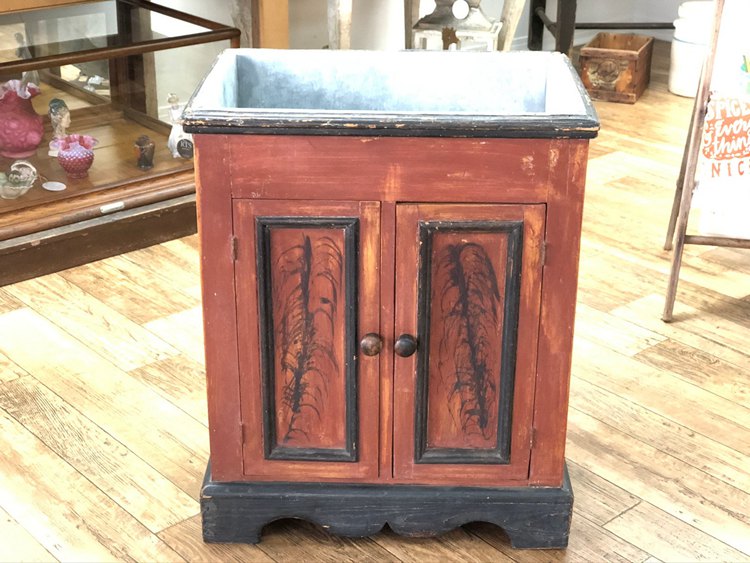
An antique dry sink is a dry sink that is old. More specifically, a dry sink is like a modern-day sink without the convenience of indoor plumbing. Instead, it is a piece of furniture used to hold a pitcher of water and a washbasin.
These sinks were standard or a staple in any well-equipped home you could find in the 19th century.
You could primarily find dry sinks in the kitchen, bathroom, or bedroom area. However, some farmers’ wives kept a dry sink on the back porch of their home. With this, someone could stop to wash their hands before proceeding to the house.
Because water would often drip onto the counter or dry sink, the furniture makers sealed the wood with a special varnish. This makes the dry sink last longer.
In describing a dry sink, it is basically a cabinet with a recessed area at the top. This hollow space of the dry sink helped to keep the water from the pitcher and the bowl or basin contained while someone washed up.
Additionally, you should know that the more expensive dry sinks had this recessed area lined with copper or any other waterproof material.
As time passed and plumbing came into existence, people replaced the dry sinks with the modern sinks and vanities we know today. This does not mean dry sinks don’t still exist. However, they are being repurposed and used for their aesthetic qualities.
What Was an Antique Dry Sink Used for?
A dry sink provided a way for people to wash their hands, produce (fruits and veggies), linens, or even shave. People started using dry sinks when they learned the importance of hygiene. So, it was an advantageous way to be more hygienic in the 19th century.
The larger, double-wide dry sinks were typically designed for kitchen usage. In comparison, homeowners kept the smaller dry sinks, which have more Victorian-style detailing, in the bedroom.
To use the dry sink, a person would pour the water from the pitcher into the large basin. In this basin, the person would wash their hands and other things.
After the person has used the water, the basin would then be removed, and the water would then be disposed of.
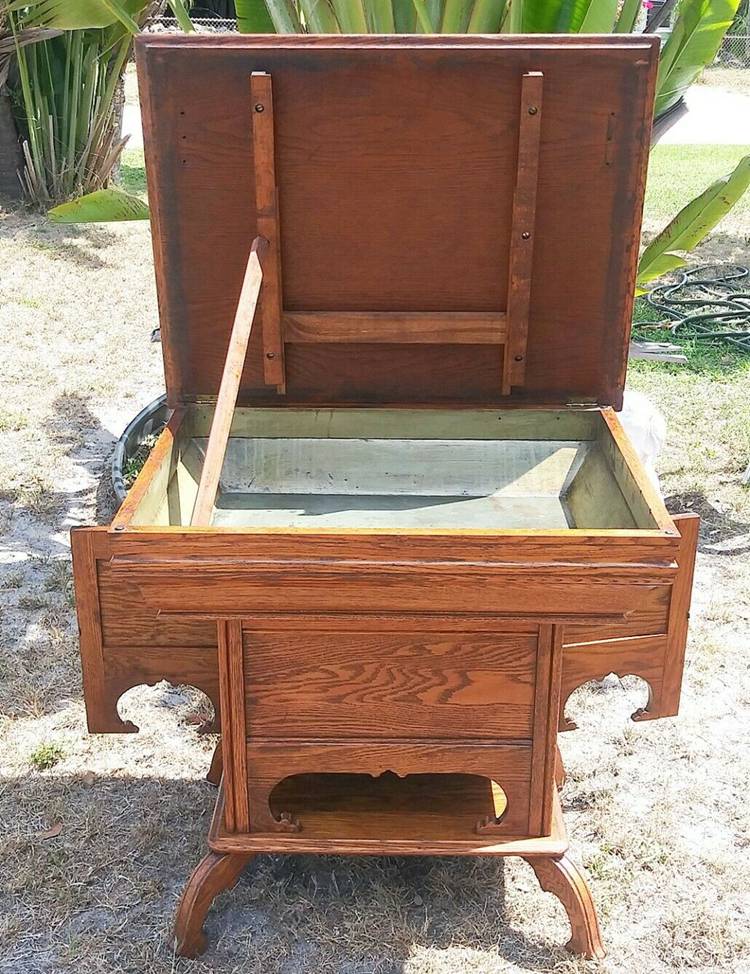
Furthermore, the typical dry sink provided users with storage areas, like one or two drawers, where you could keep your soap, towels, linens, and other personal items. Usually, the dry sink also comes with a hook or bar to hang up your towels and napkins.
Most dry sinks in the olden days were made of pine wood. However, people could choose any wood they wanted in wealthier homes. Therefore, during the Victorian era, the top of the dry sinks was level instead of having a dipped area.
The furniture makers added a marble slab across the top, which the pitcher and basin would rest. This type of modification gives off a unique, decorative feel.
Tips for Distinguishing an Antique from a Reproduction
If you do not have an antique dry sink that has been passed down through the family from generation to generation, you might need to purchase the dry sink yourself.
When shopping for antique furniture, the first thing you should know is that there are reproductions or fake antiques. For example, dry sinks are among the most reproduced pieces of furniture ever.
A reproduction is a remake made to look like an antique. But, unfortunately, these remakes are made to look so much like the real thing that a beginner in antique dealing would mistake a reproduction for a genuine antique.
However, you should follow one general rule: actual antique dry sinks are imperfect. Also, the flaws you see on an antique dry sink are inconsistent due to use and human construction.
To make selecting an antique dry sink easier, these are tips to help you distinguish an antique from a reproduction.
1. Type of Wood
The type of wood the furniture maker uses to make the dry sink can provide you with information to help you distinguish between an antique and reproduction.
When shopping for an antique dry sink, the wooden furniture you might encounter may be traditional English or American Colonial styles. The common woods you should expect to see with antique furniture like a dry sink include the following:
- Pine
- Birch
- Maple
- Walnut
- Mahogany
- Cherry
- Fruitwoods
Furniture makers from earlier periods usually used multiple types of wood in their furniture. This is because of the high cost of the woods. So, when checking the antique dry sink, pay close attention to hidden areas such as the back panel and drawer interiors.
Even if the furniture maker used primary wood for the antique dry sink, these hidden areas could have secondary wood. On the other hand, reproductions are usually made from top to bottom with the same type of wood.
2. Signs of Wear
One way to distinguish an antique dry sink from reproduction is the sign of wear and tear. An antique dry sink would obviously be well-used by the previous owners before it finds its way into your home.
For instance, water stains, rust, inconsistent colors, chipped wood, and many other signs of wear will let you know that you are getting a piece of antique furniture. These signs of wear are usually in areas that have the most contact.
But keep in mind that some manufacturers will use old nails or wood in their reproduction to make it look like an antique, so you have to be careful.
3. Hand Carving
Because of the lack of machinery in the 19th century, furniture makers hand-carved the antique dry sinks. While real hand carving is uneven and unsymmetrical, machine carving is usually smooth and symmetrical.
So, when buying your dry sink, look out for imperfections in the craftsmanship that will help you confirm that a human being carved the work. Also, when you notice modern materials like fiberboard, staples, etc., you should know it is a reproduction.
4. Odor
Do you want to know the difference between a genuine antique dry sink and reproduction? Try taking a whiff of the dry sink you wish to purchase. It may sound weird, but it will let you know if the dry sink is an authentic antique or not.
A genuine antique dry sink will smell musty and mildewed like it has been sitting in an attic for years, and that’s because it has. Meanwhile, reproductions might smell fresh, and the scent of the wood would still be discernible.
5. Check for Signs of Age
There is no way an antique dry sink will not show signs of age. Therefore, furniture that has been in existence since the 19th century will show that it is old.
Some significant symptoms of age you should look out for include shrinkage of the wood, splits, and seam separation.
6. Irregular Dovetail Joints
A dovetail joint is a joinery technique used in woodworking and furniture creation. Because the 19th century didn’t have advanced carpentry tools, furniture makers joined dovetails by hand. So, this led to the furniture having irregular dovetail joints.
If you notice that the “antique” dry sink has perfectly joined dovetail joints, then it probably isn’t a genuine antique.
What Can You Use an Antique Dry Sink for Today?
When you add an antique dry sink to your home, in this modern-day, you give it a vintage look without taking up space or having an expensive remodeling.
Thankfully, we have plumbing now, so you do not need to use the antique dry sink to wash your clothes or hands. So, what exactly can you use an antique dry sink for in your home today?
Below are some decorating ideas you can incorporate for your antique dry sink to add beauty to your home.
1. Nightstand or Vanity
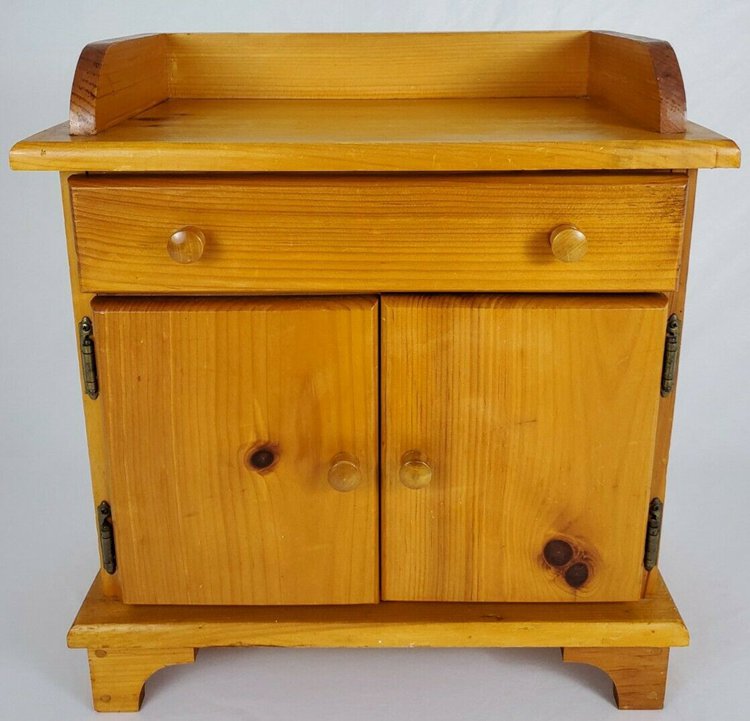
A nightstand is a small bedside table where you can keep a reading lamp, some books, your reading glasses, etc. On the other hand, a bedroom vanity is an area where you can get prepared for the day.
It can contain your makeup, jewelry, a mirror, and any other personal item you need to get ready.
Opting to use an antique dry sink for your nightstand or vanity adds a vintage feel and style to your bedroom’s interior design. In addition to its aesthetics, your dry sink will provide you with ample storage.
2. Home Office Decor
Work can be stressful at times, but you can elevate your work mood with the right environment. For example, using an antique dry sink in your home office is a great way to improve your working conditions.
Since you know that you might be in your home office for a while, it would be nice to make the environment as beautiful and comfortable as possible. For instance, you could use the antique dry sink as a work table or store books and other work documents.
3. Kitchen Island
Do you want to add a unique touch to your kitchen décor? Then swap your regular kitchen island with an antique dry sink. You could choose to use a dry sink with a repressed or leveled top; we are sure you can make it work.
Because of the cupboards and drawers that most dry sinks come with, you can get extra storage in your kitchen for your pots, pans, canned goods, cutleries, etc.
4. TV Stand
There are two major ways you can set your television. You can mount your TV on the wall with a TV bracket, or you can use a TV stand. However, you can decide to repurpose your antique dry sink and use it as a TV stand. With its hollow top, your TV will sit pretty without fear of it toppling over.
Additionally, you can store your games, consoles, DVDs, etc., in the storage compartments of your dry sink.
5. Display Case
Most people put their antique dry sinks on display; why not take it up a notch? You can turn it into a DIY display case. You use your dry sink to display decorative knick knacks, picture frames, awards, certificates, and many others.
Additionally, you can decide to repaint your dry sink to match the décor in your home while you display your souvenirs and memories.
6. Wet Bar Area
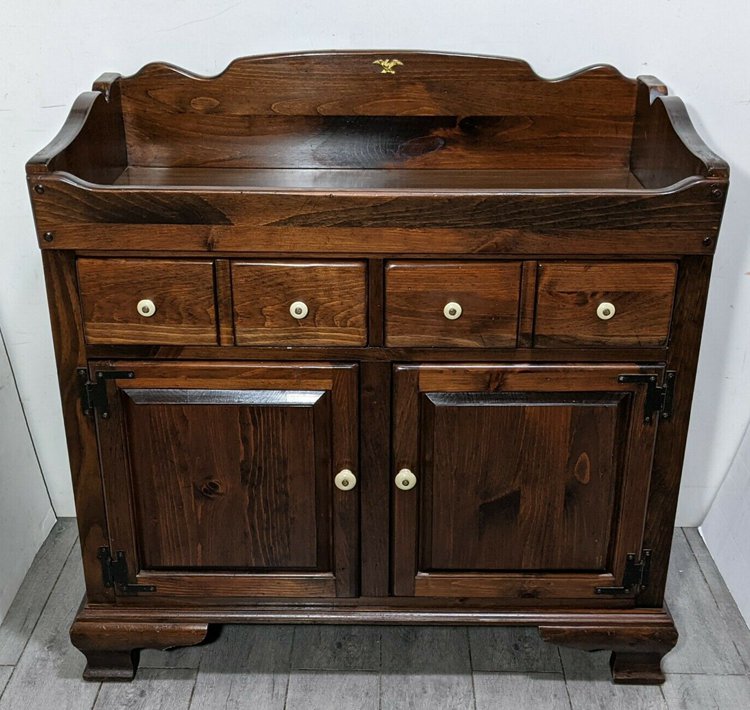
Another great way to use an antique dry sink in your home’s décor is by using it as a wet bar area. A dry sink as a wet bar area makes pouring drinks easier thanks to its repressed top.
So, even if you have an event where you need to entertain people, you would have no issues. With the antique dry sink, you can store your bottles of gin, vodka, rum, tequila, etc. Additionally, you can keep the cups and champagne flutes in the drawers.
Conclusion
Antiques add a lot of beauty to your décor. When you include a piece of versatile furniture like the antique dry sink, you are sure to find a use for it in your home.
After learning a lot about dry sinks in this article, we hope you do not just dispose of that antique dry sink sitting in your attic. Instead, you can repurpose it and give it a new lease of life.
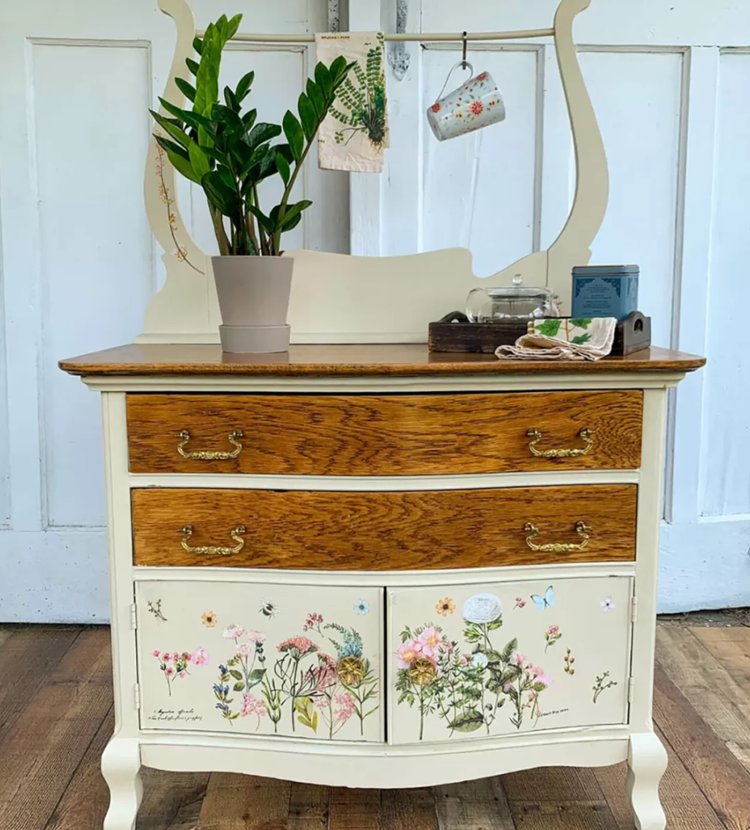






![Vintage Schwinn Bikes: [Types, Identification, and Values]](https://www.txantiquemall.com/wp-content/uploads/2022/05/5.-Schwinn-1967-Ramshorn-Fastback-Stingray-Sky-Blue-vtg-600x450.jpg)
